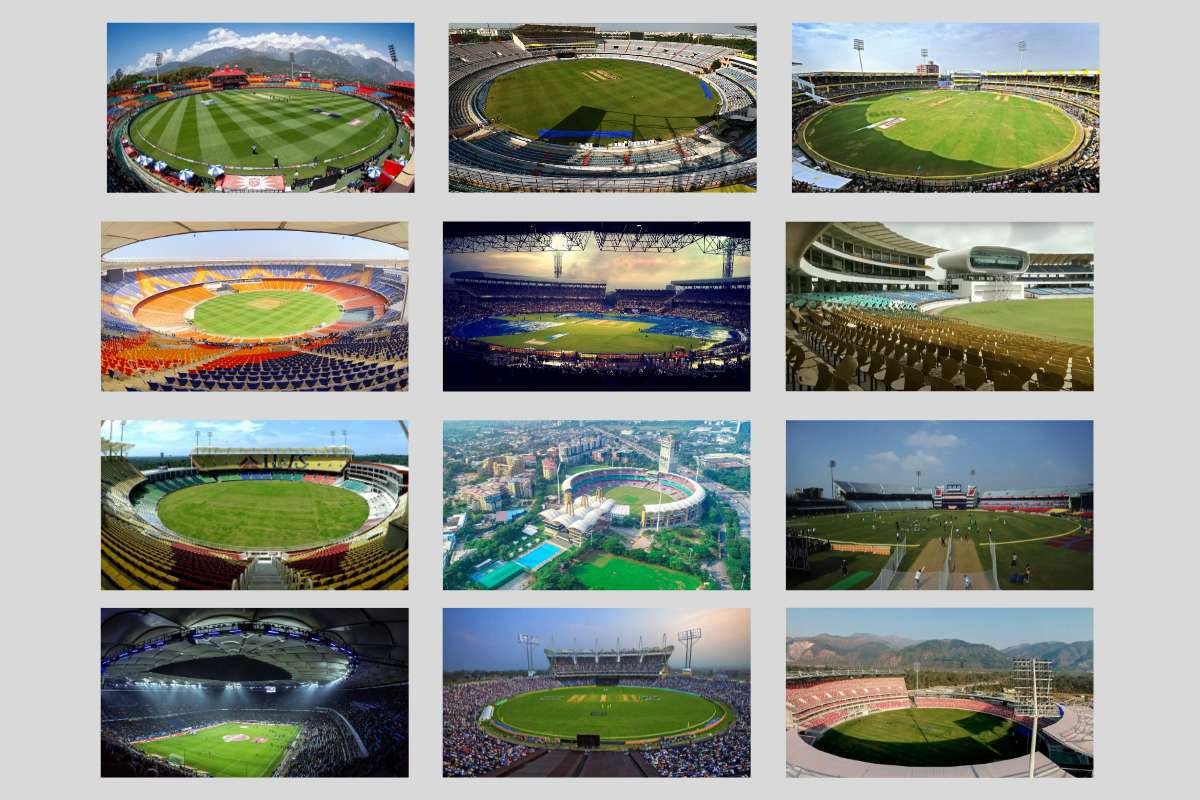If you’ve ever watched a match where the crowd roars in perfect sync, you know it’s pure emotion. Cricket is part of India’s soul. And the biggest cricket stadiums in India are where that passion finds its loudest voice.
From the echo of chants to the waves of tricolors in the stands, these grand arenas transform every match into a celebration. They’re not just massive structures; they’re places where history has been written, dreams have come true, and legends have been born.
Each stadium tells a story of unforgettable innings, record-breaking moments, and the unshakable bond between fans and the game. These grounds remind us why cricket is a way of living in India and not just a sport.
The 24 Biggest Cricket Stadiums in India Where History Was Forged
The Biggest Cricket Stadiums in India aren’t just about numbers. It’s about stories, cheers, and moments that stay forever. Across the country, each stadium carries a piece of cricket’s soul that echoes with legends of the past.
| No. | Stadium Name | Location | Capacity |
| 1 | Narendra Modi Stadium | Ahmedabad, Gujarat | 132,000 |
| 2 | Eden Gardens | Kolkata, West Bengal | 68,000 |
| 3 | Shaheed Veer Narayan Singh International Stadium | Raipur, Chhattisgarh | 65,000 |
| 4 | Rajiv Gandhi International Cricket Stadium | Hyderabad, Telangana | 55,000 |
| 5 | Ekana Cricket Stadium (BRSABV Stadium) | Lucknow, Uttar Pradesh | 50,000 |
| 6 | Greenfield International Stadium | Thiruvananthapuram, Kerala | 50,000 |
| 7 | JSCA International Stadium Complex | Ranchi, Jharkhand | 50,000 |
| 8 | Barabati Stadium | Cuttack, Odisha | 45,000 |
| 9 | D. Y. Patil Stadium | Navi Mumbai, Maharashtra | 45,000 |
| 10 | Arun Jaitley Stadium (Feroz Shah Kotla) | Delhi | 41,000 |
| 11 | Barsapara Cricket Stadium (ACA Stadium) | Guwahati, Assam | 40,000 |
| 12 | Maharaja Yadavindra Singh International Stadium | Mullanpur, Punjab | 38,000 |
| 13 | M. A. Chidambaram Stadium | Chennai, Tamil Nadu | 38,000 |
| 14 | Wankhede Stadium | Mumbai, Maharashtra | 33,000 |
| 15 | Green Park Stadium | Kanpur, Uttar Pradesh | 32,000 |
| 16 | Barkatullah Khan Stadium | Jodhpur, Rajasthan | 30,000 |
| 17 | Holkar Stadium | Indore, Madhya Pradesh | 30,000 |
| 18 | Saurashtra Cricket Association Stadium | Rajkot, Gujarat | 28,000 |
| 19 | ACA–VDCA Stadium | Visakhapatnam, Andhra Pradesh | 27,500 |
| 20 | IS Bindra Stadium | Mohali, Punjab | 27,000 |
| 21 | Sector 16 Stadium | Chandigarh | 26,000 |
| 22 | Nehru Stadium | Pune, Maharashtra | 25,000 |
| 23 | Dehradun International Cricket Stadium | Dehradun, Uttarakhand | 25,000 |
| 24 | HPCA Stadium | Dharamshala, Himachal Pradesh | 23,000 |
1. Narendra Modi Stadium, Ahmedabad – 132,000 Capacity

- Date Established: 1983
- Most Memorable Matches/Moments: ICC Cricket World Cup final, India v Australia, 19 Nov 2023.
The Narendra Modi Stadium is the pride of Indian cricket and the world’s largest. It was redeveloped in 2020 with advanced design and modern seating. The circular stands give every fan a perfect view of the field.
This venue is the largest stadium in the world, and has hosted major events, including the 2023 ICC World Cup final and IPL playoffs. Fans recall incredible moments like Shubman Gill’s record-breaking innings and intense India-Australia clashes. The crowd energy here is unmatched, especially during night games.
Its design includes 11 pitches made of different soil types, unique in world cricket. The LED floodlights and underground drainage system add to its innovation, ensuring smooth play in any weather.
2. Eden Gardens, Kolkata – 68,000 Capacity

- Date Established: 1864
- Most Memorable Matches/Moments: India v Australia, Kolkata Test 2001 (VVS Laxman 281)
Eden Gardens is one of the biggest cricket stadiums in India. Established in 1864, it carries a rich legacy of unforgettable matches. Its old charm and modern upgrades make it a perfect mix of history and comfort.
The stadium witnessed timeless moments, including VVS Laxman’s 281 against Australia in 2001. It also hosted the 2016 T20 World Cup final and numerous IPL thrillers. Every match here feels like a festival.
The atmosphere at Eden Gardens is unlike anywhere else. Roaring fans, colorful flags, and rhythmic chants make it a living symbol of Kolkata’s passion for cricket.
3. Shaheed Veer Narayan Singh International Stadium, Raipur – 65,000 Capacity

- Date Established: 2008
- Most Memorable Matches/Moments: India v New Zealand, 2nd ODI at Raipur, 21 Jan 2023
Located in Chhattisgarh, this modern stadium is known for its scenic surroundings and open design. Built in 2008, it quickly became a major venue for IPL and international T20 matches. The seating comfort and wide layout make it a delight for spectators.
It gained fame when India played New Zealand in 2010, its first international fixture. Since then, it’s hosted several high-scoring contests and domestic tournaments. Players often praise its balanced pitch.
The architecture blends modern aesthetics with natural landscapes. The sunset view from the stands makes evening matches particularly beautiful.
4. Rajiv Gandhi International Cricket Stadium, Hyderabad – 55,000 Capacity

- Date Established: 2003
- Most Memorable Matches/Moments: India v Australia, 5th ODI, Hyderabad, 5 Nov 2009
The Rajiv Gandhi Stadium has become a favorite for IPL and international matches. Its large capacity and beautiful hillside backdrop make it stand out. Fans often fill every seat during India’s home series.
Built in 2003, it has hosted many memorable encounters, including IPL finals and World Cup games. The surface generally favors batsmen, leading to entertaining contests. Local supporters are known for their loyalty and enthusiasm.
The stadium’s wide roof design provides shade and ventilation. It also offers excellent facilities for players, with top-tier dressing rooms and practice nets.
5. Ekana Cricket Stadium (BRSABV Stadium), Lucknow – 50,000 Capacity

- Date Established: 2018
- Most Memorable Matches/Moments: India v West Indies, ODI/fixtures at Ekana since 2018
The Ekana Stadium is one of India’s newest and most impressive grounds. Its design ensures visibility from every seat, with bright lighting and modern architecture. The green outfield and grand pavilions make it a treat to watch.
It has hosted India’s international games and IPL fixtures since 2018. Matches here often go down to the wire, keeping fans on edge. The balanced pitch supports both spin and pace.
Named after former Prime Minister Atal Bihari Vajpayee, the stadium represents Lucknow’s rise in Indian sports. Its world-class amenities attract global cricket events every year.

Who is the Most Handsome Cricketer in the World? Here’s the top 20
For this list, we have taken into consideration: Visual appeal and grooming standards, fan following and social media influence, brand associations and magazine features, and lastly, fitness, charisma, and personality profiling.
6. Greenfield International Stadium, Thiruvananthapuram – 50,000 Capacity

- Date Established: 2015
- Most Memorable Matches/Moments: India v New Zealand, 3rd T20I, Thiruvananthapuram, 7 Nov 2017
This stadium stands out for its eco-friendly design and scenic surroundings. Solar panels, rainwater harvesting, and natural ventilation make it a model for sustainability. The circular structure provides great sightlines from all angles.
It has hosted both ODI and T20 matches since 2015. Rain interruptions often add drama, but the efficient drainage system ensures minimal delays. The crowd here adds warmth and energy to every game.
Besides cricket, it also serves as a multi-sport arena. Its versatility reflects Kerala’s growing role in Indian sports culture.
7. JSCA International Stadium Complex, Ranchi – 50,000 Capacity

- Date Established: 2013
- Most Memorable Matches/Moments: India v Australia, 4th ODI at Ranchi, 23 Oct 2013
The JSCA Stadium in Ranchi is closely tied to MS Dhoni’s legacy. Surrounded by hills and greenery, it offers a calm and scenic setting for cricket. The stands are designed for clear, uninterrupted viewing.
Since opening in 2013, it has hosted several international and IPL matches. Many remember Dhoni’s commanding innings here, which electrified home crowds. The surface favors balanced, competitive cricket.
The stadium’s drainage system is one of India’s best, allowing matches to resume quickly after rain. Its atmosphere reflects Ranchi’s deep love for the game.
8. Barabati Stadium, Cuttack – 45,000 Capacity

- Date Established: 1958
- Most Memorable Matches/Moments: India v Sri Lanka / other notable ODIs at Cuttack with high individual scores
Barabati Stadium holds a special place in India’s cricket history. Built in 1958, it has hosted both domestic and international fixtures for decades. Its loyal fans have seen some of India’s greatest players perform here.
Kapil Dev’s match-winning spells and Tendulkar’s centuries are still remembered fondly. The stadium also continues to serve as a hub for the Ranji Trophy and local tournaments. The environment is always lively during matches.
Located near the Mahanadi River, it offers a breezy, open-air experience. The scenic backdrop adds to its charm, especially under floodlights.
9. D. Y. Patil Stadium, Navi Mumbai – 45,000 Capacity

- Date Established: 2008
- Most Memorable Matches/Moments: IPL final, 25 Apr 2010
Known for its architectural brilliance, D.Y. Patil Stadium provides an obstruction-free view from every seat. The colorful seating and canopy roof create a vibrant atmosphere. It’s also a favorite venue for concerts and cultural events.
It hosted IPL finals and women’s T20 internationals, drawing massive crowds. Players praise its true bounce and modern facilities. The energy during Mumbai matches is unmatched.
Its LED lighting system and acoustic design ensure great visuals and sound. The ground remains one of India’s most fan-friendly stadiums.
10. Arun Jaitley Stadium (Feroz Shah Kotla), Delhi – 41,000 Capacity

- Date Established: 1883
- Most Memorable Matches/Moments: Anil Kumble 10 for 74, India v Pakistan, Feroz Shah Kotla, 4–7 Feb 1999
One of India’s oldest venues, this stadium has hosted cricket since 1883. After major renovations, it now blends heritage with modern comfort. The stands are close to the pitch, creating an electric atmosphere.
Historic moments include Anil Kumble’s 10-wicket haul against Pakistan in 1999. It has also been home to numerous India-Pakistan and IPL thrillers. The pitch favors aggressive batting and sharp spin.
Renamed after Arun Jaitley in 2019, it honors a leader who supported Delhi cricket for decades. The vibrant crowds keep its legacy alive.
11. Barsapara Cricket Stadium (ACA Stadium), Guwahati – 40,000 Capacity

- Date Established: 2017
- Most Memorable Matches/Moments: India v Australia / India v Australia T20I at Guwahati, Oct 2017
The ACA Stadium has made Assam a major stop for international cricket. The view of the Brahmaputra River nearby gives it a unique charm. Its lush green outfield and colorful seating make it visually striking.
The venue hosted its first T20I in 2017 and has since seen many high-voltage matches. The local crowd is enthusiastic, celebrating every boundary with pride. It’s one of the fastest-growing venues in eastern India.
Built to ICC standards, it helps promote cricket across the northeastern states. Young players from the region now dream of playing on this ground.
12. Maharaja Yadavindra Singh International Stadium, Mullanpur – 38,000 Capacity

- Date Established: 2024
- Most Memorable Matches/Moments: Host for ICC Women’s ODI World Cup Final (2025)
This newly developed stadium in Punjab reflects the region’s growing cricket infrastructure. By hosting the ICC Women’s ODI World Cup Final for 2025, it has carved its name in history as well as on this list of the biggest cricket stadiums in India. Its modern stands and open layout give fans a clear view from all sides. The lush outfield is ideal for limited-overs cricket.
Though new, it has already hosted IPL and domestic matches. The wide playing area challenges batsmen to time their shots well. Fans here bring unmatched enthusiasm and color.
The drainage and lighting systems meet international standards. Its clean architectural style makes it a visual highlight of modern Indian stadium design.
13. M. A. Chidambaram Stadium, Chennai – 38,000 Capacity

- Date Established: 1916
- Most Memorable Matches/Moments: India v Australia, Chepauk, Sep 1986
Chepauk is India’s oldest active cricket stadium and home to passionate fans. Established in 1916, it has hosted some of the most memorable Tests in history. The Chennai crowd is famous for its respect toward both teams.
It witnessed India’s dramatic tied Test against Australia in 1986 and many of MS Dhoni’s iconic IPL moments. The sea breeze often influences the ball’s swing, adding intrigue to every match.
Recent renovations improved seating and airflow without changing its traditional charm. The ground remains a sacred place for Indian cricket followers.
14. Wankhede Stadium, Mumbai – 33,000 Capacity

- Date Established: 1975 (renovated 2011)
- Most Memorable Matches/Moments: ICC Cricket World Cup Final, India v Sri Lanka, 2 Apr 2011
Wankhede is not the largest, but it’s the most iconic. India’s 2011 World Cup win here remains unforgettable for every fan. The sound of the crowd during that final still echoes through cricket history. It is one of the biggest cricket stadiums in India, not just by size, but also by the history that it has achieved
Located near the Arabian Sea, the stadium enjoys a cool coastal breeze. Its compact structure brings fans very close to the action, creating unmatched energy. The atmosphere during IPL and Test matches is always electric.
Renovated in 2011, it now features advanced seating and lighting. Despite its size, it remains the beating heart of Indian cricket.
15. Green Park Stadium, Kanpur – 32,000 Capacity

- Date Established: 1945
- Most Memorable Matches/Moments: India v South Africa, 1st Test at Kanpur, Nov 2004
Green Park has witnessed many historic Test matches where India dominated visiting teams. The atmosphere becomes electric when the stands fill with cheering fans. The pitch often favors spinners, making matches exciting and unpredictable.
The stadium holds emotional value for Uttar Pradesh fans who’ve seen generations of cricketers grow here. It’s one of the few venues where women’s international games were played decades ago. Its old-world charm and riverside location make it a favorite for traditionalists.
The ground is named after a British lady who once practiced horse riding there. Despite its age, it continues to serve as a venue for domestic tournaments and IPL matches.
16. Barkatullah Khan Stadium, Jodhpur – 30,000 Capacity

- Date Established: 1986
- Most Memorable Matches/Moments: India v West Indies / Zimbabwe ODI fixtures hosted at Jodhpur
Set against the desert landscape, this stadium stands out for its sandy surroundings and blue seating. It hosted international games in the early 2000s before fading from the main circuit. Recently, it was revived for domestic T20 leagues, bringing fresh life to Rajasthan’s cricket scene.
The dry pitch supports spinners and slower bowlers, often producing close contests. Its open structure allows desert winds to influence play, adding a natural challenge for batsmen. Local crowds bring unmatched energy whenever matches return to this ground.
Named after Barkatullah Khan, a former chief minister of Rajasthan, the venue reflects the state’s growing cricketing culture. Its revival shows India’s commitment to expanding the game beyond metro cities.
17. Holkar Stadium, Indore – 30,000 Capacity

- Date Established: 2006
- Most Memorable Matches/Moments: India v West Indies, 4th ODI Indore, 8 Dec 2011 (Virender Sehwag 219 record chase)
Known for its small boundaries, Holkar Stadium often produces high-scoring thrillers. India’s record-breaking innings against South Africa in 2015 still stands as a highlight here. The crowd enjoys close finishes as balls fly over the ropes frequently.
Built in honor of the Holkar dynasty, it’s one of the few grounds with world-class amenities in central India. The venue’s layout keeps spectators close to the field, creating a lively experience. Floodlights and upgraded seating add to its modern look.
The pitch is known for being batting-friendly but helps seamers in the early overs. It’s a favorite IPL destination, known for its fair contests and family-friendly environment.
18. Saurashtra Cricket Association Stadium, Rajkot – 28,000 Capacity

- Date Established: 2008
- Most Memorable Matches/Moments: Cheteshwar Pujara’s double century for Saurashtra in Ranji Trophy at Rajkot
Rajkot’s SCA Stadium has become a paradise for batsmen. Several double centuries and record totals have been achieved here. The red-soil pitch supports stroke play and fast scoring.
Its modern architecture includes spacious player areas and indoor practice facilities. Fans appreciate the comfort and smooth organization during international fixtures. The venue also promotes local cricket through regular domestic tournaments.
Saurashtra’s cricket success stories, including Cheteshwar Pujara and Ravindra Jadeja, are closely tied to this ground. The stadium continues to shape the future of cricket in western India.
19. ACA–VDCA Stadium, Visakhapatnam – 27,500 Capacity

- Date Established: 2003
- Most Memorable Matches/Moments: Rohit Sharma 159 (ODI), India v West Indies, Visakhapatnam
This coastal stadium in Vizag is known for its mild weather and scenic setting. Sea breezes often affect swing, challenging even top batters. The ground has seen thrilling contests across formats, especially limited-overs games.
Spinners often enjoy good turn here, making matches tactically engaging. Its curved stands ensure fans are close to the field without any blocked views. The venue has hosted several successful international series for India.
The management maintains world-class facilities, earning praise from players and officials alike. It’s also known for excellent crowd behavior and a family-friendly environment.
20. IS Bindra Stadium, Mohali – 27,000 Capacity

- Date Established: 1993
- Most Memorable Matches/Moments: ICC Cricket World Cup 2011, India v Pakistan, 2nd Semi-Final, Mohali, 30 Mar 2011
Mohali’s IS Bindra Stadium has hosted iconic World Cup and Test matches. It gained fame for the 2011 World Cup semi-final between India and Pakistan. The well-balanced pitch provides something for both batters and bowlers.
The stadium’s design allows smooth airflow, making it one of India’s most comfortable venues. Surrounded by open fields, it’s cooler and less humid than most north Indian grounds. The stands offer clear views from every angle.
Named after Inderjit Singh Bindra, a respected cricket administrator, this ground reflects Punjab’s deep cricket roots. It’s also home to the Punjab Kings IPL team, making it a symbol of regional pride.
21. Sector 16 Stadium, Chandigarh – 26,000 Capacity

- Date Established: 1966
- Most Memorable Matches/Moments: Early ODIs and key domestic matches
Sector 16 Stadium is where some of India’s famous players, including Kapil Dev, began their careers. It has hosted ODIs in the past, featuring thrilling finishes. The ground has a compact structure and open-air stands that bring fans close to the players.
Though replaced by Mohali for international fixtures, it remains active for domestic competitions. The local crowd continues to fill seats during state matches. Its importance in Chandigarh’s cricket legacy remains strong.
The stadium’s simple layout and lush outfield make it ideal for training camps. It reflects an era when cricket was more about community than luxury.
22. Nehru Stadium, Pune – 25,000 Capacity

- Date Established: 1969
- Most Memorable Matches/Moments: India v Australia ODI fixtures
Before Pune’s new MCA Stadium was built, this venue hosted several international games. It has seen legendary performances from players like Sachin Tendulkar and Kapil Dev. The atmosphere here brings back nostalgia among older fans.
Located in the city center, it remains a key site for domestic and university tournaments. Many Ranji Trophy matches still take place on its well-maintained surface. It continues to serve as a training hub for local cricketers.
Though it lacks modern amenities, the ground’s history gives it a special identity. It stands as a reminder of how Indian cricket has evolved over the years.
23. Dehradun International Cricket Stadium – 25,000 Capacity

- Date Established: 2016
- Most Memorable Matches/Moments: Afghanistan v Bangladesh, 1st T20I at Dehradun, 2018
Built in the scenic hills of Uttarakhand, this modern stadium combines sport with nature. Its elevated position offers panoramic views of the surrounding valleys. It became globally recognized after hosting Afghanistan’s international games.
The pitch usually supports batting, but cool weather conditions keep bowlers in play. Evening games here have a unique atmosphere under bright mountain skies. Fans from nearby towns flock to enjoy the peaceful setting.
With its eco-friendly design and strong infrastructure, the venue has become a model for newer stadiums. It represents India’s expanding cricketing map into hilly regions and has become one of the biggest cricket grounds in India.
24. HPCA Stadium, Dharamshala – 23,000 Capacity

- Date Established: 2003
- Most Memorable Matches/Moments: India v Australia, 4th Test at Dharamsala, Mar 25–28, 2017
Along with being one of the biggest cricket stadiums in India, the HPCA Stadium is also one of the most breathtaking cricket grounds in the world. Snow-capped mountains form its background, offering a postcard-perfect view during matches. The clear skies and cool air make watching cricket here a serene experience.
The pitch offers bounce and seam movement, testing even seasoned batters. Fast bowlers particularly enjoy conditions that are rare in India. Despite its smaller capacity, the ground’s charm attracts global attention.
Built at high altitude, the stadium required special engineering to handle cold weather. It stands as proof of India’s ability to blend sport with nature.
Cultural Significance of Cricket in India
Across India, cricket viewership reflects the nation’s devotion. During the 2023 ICC Men’s Cricket World Cup, with 87.6 billion live viewing minutes globally. No other sport in India commands such reach as cricket dominates with the largest audience base among all sports
These massive stadiums have shaped generations of players and inspired countless dreams. From gully cricket in crowded neighborhoods to sold-out international matches under bright floodlights, each ground holds stories of pride and perseverance. Whether in a coastal city or a mountain town, the love for cricket unites people and keeps the nation’s sporting spirit alive and unstoppable
Conclusion:
When the lights dim and the echoes of cheers fade, something powerful remains, and that is the emotion that only cricket can bring. The biggest cricket stadiums in India may be vast arenas, but their true magic lies in the memories they create.
Every match played here adds a new chapter to India’s sporting legacy. From unforgettable centuries to nail-biting finishes, these grounds have witnessed moments that unite millions. They are places where generations gather, voices rise in unison, and passion takes over every heart.
Even when the stands fall silent, the stories linger; the chants, the thrill, the pride of being part of something greater. That’s what makes these stadiums timeless. They don’t just showcase the game; they celebrate the soul of Indian cricket.
FAQ
1. What’s the difference between the biggest cricket stadiums in India and older grounds?
A. Older grounds like Feroz Shah Kotla in Delhi have historical importance, while the newer and biggest cricket stadiums in India, like Narendra Modi Stadium, feature modern architecture, larger capacities, and upgraded facilities for global events.
2. How are the biggest cricket grounds in India maintained?
A. These stadiums are managed by the BCCI and local cricket associations, ensuring high-quality pitches, modern facilities, and international-standard maintenance year-round.
3. Are the biggest cricket stadiums in India used for other sports too?
A. Yes, many of the biggest cricket grounds in India also host football matches, concerts, and cultural events, showcasing their versatility and scale.






